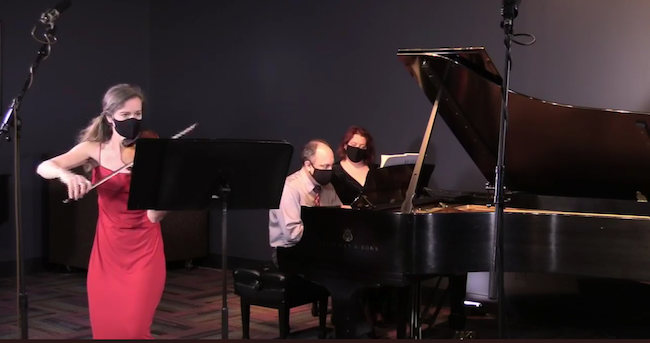by Jarrett Hoffman

That delay was odd, but apparently the problem was a mistaken concern from that ever-benevolent giant of social media companies about a copyright violation. Twenty minutes later, Cornelius and Charnofsky began once again, and the city of Cleveland crossed its fingers.
Would the performers address the remote audience? No, perhaps it was best that they just get right back into the swing of Mozart’s Sonata No. 21, whose contrasts they captured vividly — in particular the crisp and bold articulations against the flowing melodies in the first movement.
Contrast is even more ferocious in much of the music of Beethoven, and the duo absolutely relished it during the “Kreutzer” Sonata — or perhaps more fittingly the “Bridgetower” Sonata, based on its unusual premiere and the flip-flop over its dedication, a story which Cornelius shared in an engaging pre-recorded segment. In the wrong hands, Beethoven’s rough, wild, and sometimes vicious extroversion can come across as bland and predictable, but here it was breathtaking. On the opposite end of the spectrum, Cornelius and Charnofsky easily cooled down to calm and beautiful playing when the moment was right.
What’s great about a devilishly difficult work like this one is that the idea of perfection goes out the window. Instead, we can watch it like it’s a boxing match. The performers will invariably take a few punches from Beethoven — here, the thrill was watching Cornelius and Charnofsky come right back with their own through their tireless technique and unbeatable spirit.
One question worth asking: if shorter concerts are considered a better fit for streaming, what about the length of single works? The Beethoven goes for 40 minutes, and the evening as a whole went for 80 — both to me a bit long for this particular listening format. Though it’s no one’s fault, the delayed start probably didn’t help either.
Stravinsky’s Suite Italienne, based on his ballet Pulcinella, was the perfect follow-up: radically different in style, and divided into several short sections. In Pulcinella, considered the beginning of Stravinsky’s neoclassical period, he brought modern rhythm, harmony, and sensibility to a collection of older works largely of the Italian Baroque (at the time, they were all thought to be written by Pergolesi). The result is charming and witty, often delightfully snarky, and in this performance, Cornelius and Charnofsky conveyed not just the moments of genius, but the simple joys of this music.
There must have been a sigh of relief from all involved after the digital curtain closed. Sure, the technological issues had not gone away entirely — the video showed a tendency to glitch up — but the most important aspect of the stream was that it worked. Cornelius and Charnofsky could finish what they had started, and we could enjoy it as well.
Published on ClevelandClassical.com November 24, 2020.
Click here for a printable copy of this article




